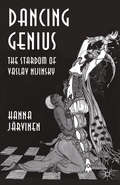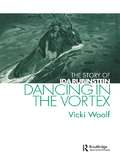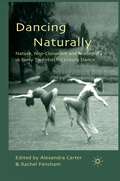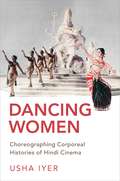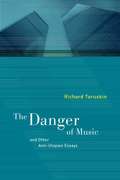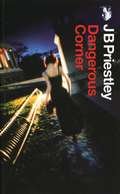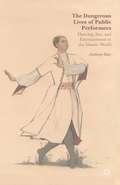- Table View
- List View
Dancing at Lughnasa: Dancing At Lughnasa; Fathers And Sons; Making History; Wonderful Tennessee; Molly Sweeney
by Brian FrielIt is 1936 and harvest time in County Donegal. In a house just outside the village of Ballybeg live the five Mundy sisters, barely making ends meet, their ages ranging from twenty-six up to forty. The two male members of the household are brother Jack, a missionary priest, repatriated from Africa by his superiors after 25 years, and the seven-year-old child of the youngest sister. In depicting two days in the life of this menage, Brian Friel evokes not simply the interior landscape of a group of human beings trapped in their domestic situation, but the wider landscape, interior and exterior, Christian and pagan, of which they are a part.
Dancing Female (Choreography and Dance Studies Series)
by Sharon E. Friedler Susan B. GlazerFirst Published in 1997. Routledge is an imprint of Taylor & Francis, an informa company.
Dancing Female (Choreography and Dance Studies Series #Vol. 12)
by Sharon E. Friedler Susan B. GlazerFirst Published in 1997. Routledge is an imprint of Taylor & Francis, an informa company.
Dancing Genius: The Stardom of Vaslav Nijinsky
by Hanna JärvinenTracing the historical figure of Vaslav Nijinsky in contemporary documents and later reminiscences, Dancing Genius opens up questions about authorship in dance, about critical evaluation of performance practice, and the manner in which past events are turned into history.
Dancing in the Vortex: The Story of Ida Rubinstein (Choreography and Dance Studies Series)
by Vicki WoolfParis at the turn of the century - Art Nouveau, Renoir, Toulouse-Lautrec and the Folies Bergere. This was the atmosphere which nurtured the artistic development of the remarkable dancer and choreographer Ida Rubinstein.This long-awaited biography gives us a unique insight into the life of a remarkable woman, responsible for a fascinating chapter of our artistic heritage. She was a chameleon, a diva, who lived many lives, overcoming the anti-Semitism of her times to enchant and captivate the highest of societies.Untrained as a dancer, Ida Rubinstein's charisma attracted collaborators such as Debussy, Stravinsky, Ravel, Cocteau, Bakst, and Benois.
Dancing in the Vortex: The Story of Ida Rubinstein (Choreography and Dance Studies Series #Vol. 20.)
by Vicki WoolfParis at the turn of the century - Art Nouveau, Renoir, Toulouse-Lautrec and the Folies Bergere. This was the atmosphere which nurtured the artistic development of the remarkable dancer and choreographer Ida Rubinstein.This long-awaited biography gives us a unique insight into the life of a remarkable woman, responsible for a fascinating chapter of our artistic heritage. She was a chameleon, a diva, who lived many lives, overcoming the anti-Semitism of her times to enchant and captivate the highest of societies.Untrained as a dancer, Ida Rubinstein's charisma attracted collaborators such as Debussy, Stravinsky, Ravel, Cocteau, Bakst, and Benois.
Dancing in the World: Revealing Cultural Confluences (Routledge Series in Equity, Diversity, and Inclusion in Theatre and Performance)
by Sinclair Ogaga Emoghene Kathleen A. SpanosHow can we create more inclusive spaces in the field of dance? This book presents a framework for dance practitioners and researchers working in diverse dance cultures to navigate academia and the professional dance field. The framework is based on the idea of "cultural confluences," conjuring up an image of bodies of water meeting and flowing into and past one another, migrating through what they refer to as the mainstream and non-mainstream. These streams are fluid categories that are associated with power, privilege, and the ability (or inability) to absorb other cultural forms in shared dance spaces. In reflective interludes and dialogues, Emoghene and Spanos consider the effects of migration on their own individual experiences in dance to understand what it means to carry culture through the body in various spaces. Through an analysis of language, aesthetic values, spaces, creative processes, and archival research practices, the book offers a collaborative model for communicating the value that marginalized dance communities bring to the field. This book will be of great interest to students, scholars, and arts administrators in dance.
Dancing in the World: Revealing Cultural Confluences (Routledge Series in Equity, Diversity, and Inclusion in Theatre and Performance)
by Sinclair Ogaga Emoghene Kathleen A. SpanosHow can we create more inclusive spaces in the field of dance? This book presents a framework for dance practitioners and researchers working in diverse dance cultures to navigate academia and the professional dance field. The framework is based on the idea of "cultural confluences," conjuring up an image of bodies of water meeting and flowing into and past one another, migrating through what they refer to as the mainstream and non-mainstream. These streams are fluid categories that are associated with power, privilege, and the ability (or inability) to absorb other cultural forms in shared dance spaces. In reflective interludes and dialogues, Emoghene and Spanos consider the effects of migration on their own individual experiences in dance to understand what it means to carry culture through the body in various spaces. Through an analysis of language, aesthetic values, spaces, creative processes, and archival research practices, the book offers a collaborative model for communicating the value that marginalized dance communities bring to the field. This book will be of great interest to students, scholars, and arts administrators in dance.
Dancing Naturally: Nature, Neo-Classicism and Modernity in Early Twentieth-Century Dance
by Alexandra Carter and Rachel FenshamA renewed interest in nature, the ancient Greeks, and the freedom of the body was to transform dance and physical culture in the early twentieth century. The book discusses the creative individuals and developments in science and other art forms that shaped the evolution of modern dance in its international context.
Dancing on the Edge (Screen and Cinema)
by Stephen PoliakoffSet in a time of immense change, Dancing on the Edge tells the story of a black jazz group, the Louis Lester Band, as they rise to fame, entertaining guests at exclusive high society gatherings in 1930s London. While many recoil at the presence of black musicians in polite society, the capital's more progressive socialites, including younger members of the Royal Family, take the band under their wing.In this explosive five-part series, Stephen Poliakoff returns to television with his most ambitious work to date. Dancing on the Edge provides a new angle on an extraordinary time in history, giving us a piercingly original vision of Britain in the 1930s; a time of glamour, hardship, vibrant new music and financial meltdown. Combining the rich characterisation of Shooting The Past with the epic sweep of The Lost Prince and inspired by true stories of the era, Dancing on the Edge was produced by Ruby Film and Television for BBC2.Also included is the innovative epilogue to the whole drama, Interviewing Louis, where music journalist Stanley conducts a combative in-depth interview with Louis Lester. This funny and disturbing drama complements the main story perfectly while leading us towards a shocking and unexpected conclusion.
Dancing on the Edge (Screen and Cinema)
by Stephen PoliakoffSet in a time of immense change, Dancing on the Edge tells the story of a black jazz group, the Louis Lester Band, as they rise to fame, entertaining guests at exclusive high society gatherings in 1930s London. While many recoil at the presence of black musicians in polite society, the capital's more progressive socialites, including younger members of the Royal Family, take the band under their wing.In this explosive five-part series, Stephen Poliakoff returns to television with his most ambitious work to date. Dancing on the Edge provides a new angle on an extraordinary time in history, giving us a piercingly original vision of Britain in the 1930s; a time of glamour, hardship, vibrant new music and financial meltdown. Combining the rich characterisation of Shooting The Past with the epic sweep of The Lost Prince and inspired by true stories of the era, Dancing on the Edge was produced by Ruby Film and Television for BBC2.Also included is the innovative epilogue to the whole drama, Interviewing Louis, where music journalist Stanley conducts a combative in-depth interview with Louis Lester. This funny and disturbing drama complements the main story perfectly while leading us towards a shocking and unexpected conclusion.
Dancing with Georges Perec: Embodying Oulipo (ISSN)
by Leslie SatinThis book explores the relationship of the life and work of the remarkable Parisian-Jewish writer Georges Perec (1936–1983) to dance."Dancing" addresses art-making parallels and their personal and sociocultural contexts, including Perec’s childhood loss of his parents in the Holocaust and its repercussions in the significance of the body, everydayness, space, and attention permeating his work. This book, emerging from the author Leslie Satin’s perspective as a dancer and scholar, links Perec’s concerns with those of dance and demonstrates that Perec’s work has implications for dance and how we think about it. Moreover, it is framed as a performative autobiographical enactment of the author's relationship to Perec, periodically linking their written, danced, and imagined lives.This exploration will be of great interest to dancers, dance scholars, and dance students interested in contemporary experimental dance and contemporary dance.
Dancing with Georges Perec: Embodying Oulipo (ISSN)
by Leslie SatinThis book explores the relationship of the life and work of the remarkable Parisian-Jewish writer Georges Perec (1936–1983) to dance."Dancing" addresses art-making parallels and their personal and sociocultural contexts, including Perec’s childhood loss of his parents in the Holocaust and its repercussions in the significance of the body, everydayness, space, and attention permeating his work. This book, emerging from the author Leslie Satin’s perspective as a dancer and scholar, links Perec’s concerns with those of dance and demonstrates that Perec’s work has implications for dance and how we think about it. Moreover, it is framed as a performative autobiographical enactment of the author's relationship to Perec, periodically linking their written, danced, and imagined lives.This exploration will be of great interest to dancers, dance scholars, and dance students interested in contemporary experimental dance and contemporary dance.
Dancing with Philoctetes: Reflections on Pain and Remembrance
by Abigail AkaviaAbandoned by his community, doomed to a solitary existence with his voice as sole companion: can Sophocles’ Philoctetes still speak to us? What do his screams have to say? Dancing with Philoctetes: Reflections on Pain and Remembrance juxtaposes a new adaptation of Sophocles’ play with an essay describing the process of bringing it to life in a world on the brink of a pandemic. Akavia investigates Sophocles’ nuanced portrayal of the fragility of empathy in the face of suffering, and also shares the challenges of embodying and vocalizing Sophocles’ text onstage. She proposes that the pandemic and its aftermath offer a renewed perspective on Philoctetes’ thematization, not just of empathy and disease, but of the longing to return: to home, to health, to what memory holds. Akavia’s treatment of Philoctetes starts out from his body and voice and journeys on to loneliness, toxic masculinity, nostalgia, cancer, dreaming, parenthood, language, ballet lessons, siblings, music, and growing up. Here, scholarship and creative non-fiction combine to tell a story of reading, performing, thinking about, and living (through) tragedy.
Dancing Women: Female Bodies Onstage
by Sally BanesDancing Women: Female Bodies Onstage is a spectacular and timely contribution to dance history, recasting canonical dance since the early nineteenth century in terms of a feminist perspective. Setting the creation of specific dances in socio-political and cultural contexts, Sally Banes shows that choreographers have created representations of women that are shaped by - and that in part shape - society's continuing debates about sexuality and female identity. Broad in its scope and compelling in its argument Dancing Women: * provides a series of re-readings of the canon, from Romantic and Russian Imperial ballet to contemporary ballet and modern dance * investigates the gaps between plot and performance that create sexual and gendered meanings * examines how women's agency is created in dance through aspects of choreographic structure and style * analyzes a range of women's images - including brides, mistresses, mothers, sisters, witches, wraiths, enchanted princesses, peasants, revolutionaries, cowgirls, scientists, and athletes - as well as the creation of various women's communities on the dance stage * suggests approaches to issues of gender in postmodern dance Using an interpretive strategy different from that of other feminist dance historians, who have stressed either victimization or celebration of women, Banes finds a much more complex range of cultural representations of gender identities.
Dancing Women: Female Bodies Onstage
by Sally BanesDancing Women: Female Bodies Onstage is a spectacular and timely contribution to dance history, recasting canonical dance since the early nineteenth century in terms of a feminist perspective. Setting the creation of specific dances in socio-political and cultural contexts, Sally Banes shows that choreographers have created representations of women that are shaped by - and that in part shape - society's continuing debates about sexuality and female identity. Broad in its scope and compelling in its argument Dancing Women: * provides a series of re-readings of the canon, from Romantic and Russian Imperial ballet to contemporary ballet and modern dance * investigates the gaps between plot and performance that create sexual and gendered meanings * examines how women's agency is created in dance through aspects of choreographic structure and style * analyzes a range of women's images - including brides, mistresses, mothers, sisters, witches, wraiths, enchanted princesses, peasants, revolutionaries, cowgirls, scientists, and athletes - as well as the creation of various women's communities on the dance stage * suggests approaches to issues of gender in postmodern dance Using an interpretive strategy different from that of other feminist dance historians, who have stressed either victimization or celebration of women, Banes finds a much more complex range of cultural representations of gender identities.
Dancing Women: Choreographing Corporeal Histories of Hindi Cinema
by Usha IyerDancing Women: Choreographing Corporeal Histories of Hindi Cinema, an ambitious study of two of South Asia's most popular cultural forms cinema and dance historicizes and theorizes the material and cultural production of film dance, a staple attraction of popular Hindi cinema. It explores how the dynamic figurations of the body wrought by cinematic dance forms from the 1930s to the 1990s produce unique constructions of gender, sexuality, stardom, and spectacle. By charting discursive shifts through figurations of dancer-actresses, their publicly performed movements, private training, and the cinematic and extra-diegetic narratives woven around their dancing bodies, the book considers the "women's question" via new mobilities corpo-realized by dancing women. Some of the central figures animating this corporeal history are Azurie, Sadhona Bose, Vyjayanthimala, Helen, Waheeda Rehman, Madhuri Dixit, and Saroj Khan, whose performance histories fold and intersect with those of other dancing women, including devadasis and tawaifs, Eurasian actresses, oriental dancers, vamps, choreographers, and backup dancers. Through a material history of the labor of producing on-screen dance, theoretical frameworks that emphasize collaboration, such as the "choreomusicking body" and "dance musicalization," aesthetic approaches to embodiment drawing on treatises like the Natya Sastra and the Abhinaya Darpana, and formal analyses of cine-choreographic "techno-spectacles," Dancing Women offers a variegated, textured history of cinema, dance, and music. Tracing the gestural genealogies of film dance produces a very different narrative of Bombay cinema, and indeed of South Asian cultural modernities, by way of a corporeal history co-choreographed by a network of remarkable dancing women.
Dancing Women: Choreographing Corporeal Histories of Hindi Cinema
by Usha IyerDancing Women: Choreographing Corporeal Histories of Hindi Cinema, an ambitious study of two of South Asia's most popular cultural forms cinema and dance historicizes and theorizes the material and cultural production of film dance, a staple attraction of popular Hindi cinema. It explores how the dynamic figurations of the body wrought by cinematic dance forms from the 1930s to the 1990s produce unique constructions of gender, sexuality, stardom, and spectacle. By charting discursive shifts through figurations of dancer-actresses, their publicly performed movements, private training, and the cinematic and extra-diegetic narratives woven around their dancing bodies, the book considers the "women's question" via new mobilities corpo-realized by dancing women. Some of the central figures animating this corporeal history are Azurie, Sadhona Bose, Vyjayanthimala, Helen, Waheeda Rehman, Madhuri Dixit, and Saroj Khan, whose performance histories fold and intersect with those of other dancing women, including devadasis and tawaifs, Eurasian actresses, oriental dancers, vamps, choreographers, and backup dancers. Through a material history of the labor of producing on-screen dance, theoretical frameworks that emphasize collaboration, such as the "choreomusicking body" and "dance musicalization," aesthetic approaches to embodiment drawing on treatises like the Natya Sastra and the Abhinaya Darpana, and formal analyses of cine-choreographic "techno-spectacles," Dancing Women offers a variegated, textured history of cinema, dance, and music. Tracing the gestural genealogies of film dance produces a very different narrative of Bombay cinema, and indeed of South Asian cultural modernities, by way of a corporeal history co-choreographed by a network of remarkable dancing women.
Dandy Dick (Oberon Modern Plays)
by Arthur Wing Pinero Christopher LuscombeWritten in Brighton in 1887, Dandy Dick is tells the hilarious story of the Very Reverend Augustin Jedd, a pillar of Victorian respectability, who preaches regularly against the evils of horse racing and gambling. However, a visit from his tearaway sister, Georgiana, leads him to risk all at the races, much against his better judgement. Mayhem ensues, with romantic intrigue, mistaken identity and a runaway horse. A glorious British comedy, Dandy Dick is a rarely seen treasure that so richly deserves to be revived again, for the first time in almost fifteen years.
Dandy in the Underworld (Oberon Modern Plays)
by Sebastian Horsley Tim FountainWith a childhood surrounded by alcoholism and petty cruelties, an adolescence of rebellion and punkish anarchy and an adulthood peppered with heroin addiction, voluntary crucifixion, failed suicide and a penchant for sex with prostitutes, Sebastian Horsley’s life was always destined to become a work of art. An artist, dandy and author who was perhaps best known for having undergone a voluntary crucifixion in the Philippines before beginning a regular column in The Erotic Review, Horsley’s memoirs focused on his dysfunctional family, his drug addictions, sex, and his love of prostitutes, and unsurprisingly became a cult literary sensation. Soho Theatre's theatrical version, has been adapted from Horsley’s no-holds-barred memoir and directed by fellow moral delinquent Tim Fountain. This insane tale of the prototype of modern day dandyism has now found its spiritual platform in the heart of the crazy village he likes to call home. Dandy In The Underworld premiered at Soho Theatre in the summer of 2010.
The Danger of Music: and Other Anti-Utopian Essays (PDF)
by Richard Taruskin"The Danger of Music" gathers some two decades of Richard Taruskin's writing on the arts and politics, ranging in approach from occasional pieces for major newspapers such as the "New York Times" to full-scale critical essays for leading intellectual journals. Hard-hitting, provocative, and incisive, these essays consider contemporary composition and performance, the role of critics and historians in the life of the arts, and the fraught terrain where ethics and aesthetics interact and at times conflict.Many of the works collected here have themselves excited wide debate, including the title essay, which considers the rights and obligations of artists in the aftermath of the 9/11 terrorist attacks. In a series of lively postscripts written especially for this volume, Taruskin, America's 'public' musicologist, addresses the debates he has stirred up by insisting that art is not a utopian escape and that artists inhabit the same world as the rest of society. Among the book's forty-two essays are two public addresses - one about the prospects for classical music at the end of the second millennium C. E., the other a revisiting of the performance issues previously discussed in the author's "Text and Act" (1995) - that appear in print for the first time.
Dangerous Border Crossers
by Guillermo Gomez-PenaThis anthology of Gómez-Peña's performance chronicles, diary entries, poems, essays, and texts, sheds an extraordinary light on the life and work of this migrant provocateur.
Dangerous Border Crossers
by Guillermo Gomez-PenaThis anthology of Gómez-Peña's performance chronicles, diary entries, poems, essays, and texts, sheds an extraordinary light on the life and work of this migrant provocateur.
Dangerous Corner: The Rise Of The Aztecs (Oberon Modern Plays Ser.)
by Jb PriestleyAt their stylish country retreat, Freda and Robert Caplan host a dinner party for their colleagues and friends, all executives at a transatlantic publishing company. Young, beautiful and successful they have the world at their feet.Then a cigarette box and an ill-considered remark spark off a relentless series of revelations and other, more dangerous secrets are painfully exposed. As the truth spills out about the suicide of Robert's clever, reckless brother, and the group's perfect lives begin to crumble, the cost of professional and social success becomes frighteningly plain.
The Dangerous Lives of Public Performers: Dancing, Sex, and Entertainment in the Islamic World
by A. ShayExamining performers from the ancient Mediterranean world to the modern Islamic Middle East, including India and Pakistan, Shay explores the careers, artistic performances, and legacies of these individuals who were forced to produce entertainment and art for, and have sex with, any and all patrons.


